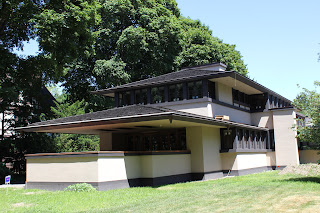 The house, now undergoing a full restoration, was built for a successful businessman, Edward E. Boynton in 1908. It is an example of a Wright "Prairie" house, the furthest East one of these had been built. Legend has it that Wright got along very well with Boynton and his daughter, and decided to personally supervise the construction. It is said he often slept on site - in a simple lean-to where he sustained himself by eating mainly "raw carrots".
The house, now undergoing a full restoration, was built for a successful businessman, Edward E. Boynton in 1908. It is an example of a Wright "Prairie" house, the furthest East one of these had been built. Legend has it that Wright got along very well with Boynton and his daughter, and decided to personally supervise the construction. It is said he often slept on site - in a simple lean-to where he sustained himself by eating mainly "raw carrots".The house also featured furniture designed by Wright, as well as the original landscaping and layout of the grounds. It is the only home designed completely by Wright in Rochester.





















